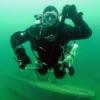
Instructor gear for teaching
#1

Posted 03 August 2005 - 08:56 PM
#2

Posted 03 August 2005 - 11:00 PM
One, I think it's a good idea for students to see as many different gear configurations as they can during class.
Two, I think it's a good idea that the students understand why the instructor wears the gear that he or she wears.
My solution to this is that I have my students wear the same gear that I wear, which is a backplate/wing BC with a bungied necklace backup regulator and 5' long hose for the primary regulator, and then at some point during the class I show them what a "typical" rig looks like.
I feel that if I believe a certain gear configuration is optimal, I'd be doing my students a disservice to teach them in gear that I felt was suboptimal.
Usually, during the last dives we do as a class, I wear my doubles instead of a single so that they can see what a doubles rig looks like, and get some idea of how it functions.
-david (who can already feel the hot sports opinions brewing on this...)
Psalms 107:23-24
#3

Posted 04 August 2005 - 12:06 AM
Another has a 'teaching' BC and 'fun diving' BC.
Another instructor has a tech rig and a recreational rig. I've only assisted with him in the pool, but he used his recreational rig.
The instructors that have dry suits, generally wear them.
I only have one BC, but I'll likely get a second for assisting with classes once I finish my DM. My current BC is the Mares V1000 AT (Air Trim). So it doesn't have a corrigated hose. Makes things kinda confusing for Rescue students
So...to answer your question. IMHO, when the instructor is going to be demonstrating, which is the pool sessions in the PADI system, he/she should be in a rig similar to what the students are using. Once you go to open water, all bets are off, as the student should be able to do the skill w/o further demonstration from the instructor.
I kinda halfway agree w/David. I do think it is a good idea to see other configurations. However, when demonstrating, I think your rig should look like the most common setup ppl will see/use.
-Warthog
#4

Posted 04 August 2005 - 04:54 AM
Seeing and using different types of equipment is good for students. Most of us can't afford to have different styles available for students to try. I do agree it is important to demonstrate skills using equipment similar to what students are using, that way they don't have to guess about how a skill is performed. At times other than demos, I have no problem with an instructor using different styles of equipment.
I further think the concept of "tech" gear and "tech" diving is an artificial one that has no useful meaning.
DSSW,
WWW™
#5

Posted 04 August 2005 - 09:34 AM
The last few airshares that I have had to do I used my seven foot hose and was very pleased with the results vice having to be right up close to them in order to grab their BC. It also makes it difficult to stay horizontal on ascent with a short hose and being right in the other diver's face. I know of few shops left that teach "pass the octo". Nearly everyone that I work with says that the back-up is for the diver that still has lots of gas. The primary belongs to the OOG diver on an airshare. One of the dive shops that I deal with has gone exclusively to teach OW with a five ft. hose and bungied back-up. It is easier to swim side by side and keep everything like a normal dive on the way up.I teach with what I wear when I dive for fun. The BCs I loan my students in class are all similar. I do that because I agree with David, you should provide the best gear possible for your classes. While I don't use a BP/Wing combo, I have used them. IMHO, it is an excellent BC and there's no reason not to teach an OW class with it. I disagree with using a long hose in situations where a long hose is not necessary. If you are diving in caves or making tight penetrations of wrecks, the long hose is a necessary piece of equipment. In those situations, you'll need to move single file at times and that's impossible to do while sharing air with a short hose. People making those types of dives are more highly trained and more experienced than the average diver, the chances of panic is greatly reduced because of the extra training and experience. It's fairly common for OOA (Out of Air) divers to panic. For this reason, when sharing air, I always take a firm hold on the OOA diver's BC as I pass them my octopus. I want them close and in my control, too much hose gets in the way.
Seeing and using different types of equipment is good for students. Most of us can't afford to have different styles available for students to try. I do agree it is important to demonstrate skills using equipment similar to what students are using, that way they don't have to guess about how a skill is performed. At times other than demos, I have no problem with an instructor using different styles of equipment.
I further think the concept of "tech" gear and "tech" diving is an artificial one that has no useful meaning.
But, I haven't done any "official" DiveCon work since last summer. My work schedule doesn't allow me to participate in a four or five week class with all of the class sessions involved. Money is not the issue. Shop policy is that if I am assisting with a class, I use more standard BC and hose set-up. I do use a SeaQuest Airsource on my class rig. I have never owned a standard octopus set-up. That drives my preference for the "pass the primary" method as well.
If I used what I dive for fun, most open water students would run away screaming that it was too heavy, LOL. So, I can't use that for a criteria.
BTW, there are training organizations that require that all classes be taught with a long hose, BP/W. etc. I don't care for them, but I will support that the quality of their training has never been questioned to my knowledge.
Edited by Diverbrian, 05 August 2005 - 09:57 AM.
#6

Posted 04 August 2005 - 09:43 AM
There's no need to remain horizontal on ascent. There is a need to keep control of and eye contact with someone who might panic at any second. I usually remain horizontal for my ascents too, but when a diver is OOA, you need to concern yourself with other priorities. Reducing the likelyhood of panic is one such priority.
It doesn't matter if you pass the regulator in your mouth and pick up your own octopus or pass the octopus, both methods work quite well. I teach my students to be able to react well to either method.
DSSW,
WWW™
#7

Posted 04 August 2005 - 10:49 AM
I do not believe in forcing anyone, but I think it is important to present the information and make the best recommendations from what you know. Present all sides to issues during instruction so that students can make their own choices after acquiring that knowledge. Let the students see and know about types of gear that others will be diving out there, and what to do when diving in groups where these divers are present.
I will tell them all of this and that they should start off with the best configuration possible right from the start. That way, they will come to know it by second nature without having to re-learn their equipment as they become more advanced. After that, it is their call.
I just put together a group for an instructor friend of mine (I am retired from instruction these days). One student went with wings and the other, who had been trained years ago, decided to stick with a traditional BC. Both went with a long hose. Even on their check out dives in the ocean, they looked better than divers I have seen having more than 50 dives. It was pretty impressive.
Edited by ScubaDadMiami, 04 August 2005 - 10:50 AM.
"For the diligent diver, closed circuit rebreathers are actually safer than open circuit scuba." Tom Mount
#8

Posted 04 August 2005 - 10:51 AM
First, if a diver is OOA, I wanna give him/her a known working regulator, and that's the one in my mouth. I don't wanna fumble hunting for an octopus.
Second, a 5 foot hose is is only 20 inches longer than the typical octopus hose. 20 inches isn't a lot. I can still easily manage a panicked diver on a 5 foot hose, and if I need to, I can easily grapple them. I don't put new divers on a seven foot hose like I would use in an overhead. The 5 footer is easy to manage.
It also is a much more streamlined configuration than the typical recreational rig, and the skills they learn with the 5' hose translate directly without them having to relearn anything as their diving progresses.
I should have made it clear, however, that I don't teach the "once a year" kind of divers... I teach divers that expect to be actively diving year round. For the more typical recreational divers, I just refer them to another instructor. Since I teach for fun, rather than for a living, it makes everyone's lives more pleasant that way.
I agree that one doesn't HAVE to ascend horizontally, but it makes life easier for everyone. In the conventional "grapple", both divers go vertical, at least partially if not completely. That process changes the buoyancy of both divers, making both positively buoyant (assuming they were neutral to start). Then both divers wind up coping with the OOA, the grapple, positive buoyancy, and the vertical position in the water which decreases hydrodynamic resistance to vertical movement in the water column.
It's my opinion that the long hose is a better configuration than the typical reg configuration (just my opinion, which I understand may be different than yours). But since I believe that, it's also what I teach.
-david
Psalms 107:23-24
#9

Posted 04 August 2005 - 11:13 AM
Thanks,Gotta disagree (respectfully) with you Walter.
First, if a diver is OOA, I wanna give him/her a known working regulator, and that's the one in my mouth. I don't wanna fumble hunting for an octopus.
Second, a 5 foot hose is is only 20 inches longer than the typical octopus hose. 20 inches isn't a lot. I can still easily manage a panicked diver on a 5 foot hose, and if I need to, I can easily grapple them. I don't put new divers on a seven foot hose like I would use in an overhead. The 5 footer is easy to manage.
It also is a much more streamlined configuration than the typical recreational rig, and the skills they learn with the 5' hose translate directly without them having to relearn anything as their diving progresses.
I should have made it clear, however, that I don't teach the "once a year" kind of divers... I teach divers that expect to be actively diving year round. For the more typical recreational divers, I just refer them to another instructor. Since I teach for fun, rather than for a living, it makes everyone's lives more pleasant that way.
I agree that one doesn't HAVE to ascend horizontally, but it makes life easier for everyone. In the conventional "grapple", both divers go vertical, at least partially if not completely. That process changes the buoyancy of both divers, making both positively buoyant (assuming they were neutral to start). Then both divers wind up coping with the OOA, the grapple, positive buoyancy, and the vertical position in the water which decreases hydrodynamic resistance to vertical movement in the water column.
It's my opinion that the long hose is a better configuration than the typical reg configuration (just my opinion, which I understand may be different than yours). But since I believe that, it's also what I teach.
-david
I knew that I wasn't completely crazy here.
With a five ft. hose, you have the option to grab the diver's BC or not. With the traditional shorter primary you have removed that option.
Keep in mind that in a few years, I will likely be diving a rebreather for my "fun diving" which will change my gas sharing protocols once again. I am talking to a friend of mine about doing a rebreather course and gas blender course while I am in Brockville this year or Plattsburgh, NY next year.
Then, I will most certainly be using more traditional gear in the classes that I plan to be assisting with and not rebelling as much. You aren't going to demo too many skills for students on a rebreather.
Edited by Diverbrian, 04 August 2005 - 11:26 AM.
#10

Posted 04 August 2005 - 11:34 AM
The reason is that her college's gear (she teaches through a college in Ohio) is not set up that way and stays in gear similar to her students. It allows her students to see the "other side" and have a friendly person around who will answer questions as to why their gear is set up differently. I have also been instrumental in telling a few of her "would-be deep adventurers" what kind of problems that you can have in deep, cold water as I have a little more recent experience in those matters than some of her divemasters and I will frankly tell them what can happen if they are unprepared. It has caused a few of her students to slow down before diving to insane depths for no reason other than to say that they have done it.
So, different can be good in gear configurations shown to a class.
#11

Posted 04 August 2005 - 03:29 PM
#12

Posted 04 August 2005 - 03:35 PM
That's probably a good compromise DiverBrain. I guess a lot of your rig configuration depends on the type of diver the student expects to become (as Dave touched on).Oh, I know of one instructor that invites me to "dive along" (unofficially assist) with her OW dives as she knows that I have doubles, BP/W, long hose, etc.
The reason is that her college's gear (she teaches through a college in Ohio) is not set up that way and stays in gear similar to her students. It allows her students to see the "other side" and have a friendly person around who will answer questions as to why their gear is set up differently. I have also been instrumental in telling a few of her "would-be deep adventurers" what kind of problems that you can have in deep, cold water as I have a little more recent experience in those matters than some of her divemasters and I will frankly tell them what can happen if they are unprepared. It has caused a few of her students to slow down before diving to insane depths for no reason other than to say that they have done it.
So, different can be good in gear configurations shown to a class.
#13

Posted 04 August 2005 - 03:37 PM
That seems pretty dismal. Is this a conjecture or do you facts to back up those numbers.Most newly certified divers will NEVER dive inside a wreck, cave, or below 130 feet. To be honest, most OW students will make less that twenty dives in thier lifetime. Most will rent gear a few times that will be the typical recreational package. Why would we not want them training in the gear they will be diving? To do anything different, in my opinion, is somewhat skewed.
#14

Posted 04 August 2005 - 04:00 PM
#15

Posted 04 August 2005 - 04:10 PM
Talk to divers you meet, most will fit into that model. In fact, why am I an old man in diving? Why do people think I have logged an awesome number of dives? Only because most people don't stay in diving very long. Objectively, I have not been diving that long, nor do I have that many dives. It's only when compared to the norm, does it seem like a long time and a large number of dives. If most people stayed in diving, I'd still be considered a pup.
Edited by Walter, 04 August 2005 - 04:13 PM.
DSSW,
WWW™
0 user(s) are reading this topic
0 members, 0 guests, 0 anonymous users

















